
 Copyright © Michael Richmond.
This work is licensed under a Creative Commons License.
Copyright © Michael Richmond.
This work is licensed under a Creative Commons License.
Executive summary: I didn't detect any occultation. Video compression with the Cinepak codec offers a nice decrease in size (by factor of about 6) with only a small increase in noise (by a factor of about 20 percent). Video compression with the DivX codec decreases the accuracy of photometry a lot.
Table of contents:
I observed the asteroid (31) Metis occult the star TYC 2979-00969-1 on UT Oct 7, 2006, from the RIT Observatory:
Latitude +43.0758 degrees North = +43:04:33 Longitude 77.6647 degrees West of Greenwich = 77:39:53 W Altitude 168 meters Meade LX200GPS 12-inch f/10 Schmidt-Cassegrain telescope PC164C CCD video camera Kiwi OSD GPS video time inserter Garmin 16 GPS random old VCR
The nice Aladin tool shows that the target star, "A", has a close companion, "C", about 16 arcseconds to the northwest. The brighter star "B" has magnitude Vt = 10.1, about half a magnitude brighter than the target star.

I videotaped the event under decent conditions. The star was very low in the sky, only about 19 degrees above the very bright north-eastern horizon, and the nearly full Moon made the sky even brighter. Nonetheless, I could see all three stars on the TV screen in the dome. I did not detect any dip in brightness at the predicted time, around UT 05:27:05, but brought the tape home for further analysis.
I digitized one minute of the tape using the Canopus ADVC 110. In its raw digitized form, the clip occupies about 240 MBytes -- yikes!
When I analyzed the tape (for the details, read the next section) I found no evidence for any dip in the target star's apparent brightness.

So, I conclude that there was no occultation at my location.
Tests of different video compression algorithms
In this section, I will describe very simple tests of three different methods for turning the raw digital video clip into individual frames for analysis. In each case, once I had a set of individual frames, I followed this procedure:
I tried three methods for turning the video clip into individual JPEG frames (1754 in each case):
Method movie file size individual JPEG total JPEG
(MBytes) size (Kbytes) size (MBytes)
---------------------------------------------------------------------------
Direct --- 217 383
Cinepak 37 155 272
DivX 10 12 22
---------------------------------------------------------------------------
Below are samples of one frame from each method. I zoom in to the target star and its nearby faint companion. The contrast is set in each case so that zero counts shows as pure black, and 100 counts as pure white. The direct frame is first (on the left), then the Cinepak frame, and finally the heavily compressed DivX frame.
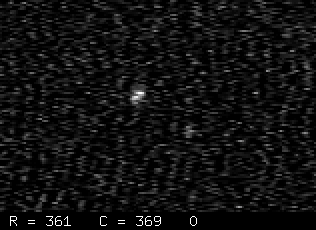
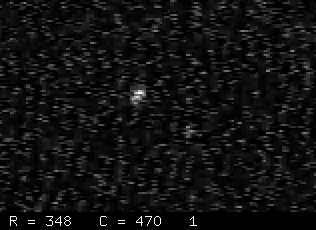
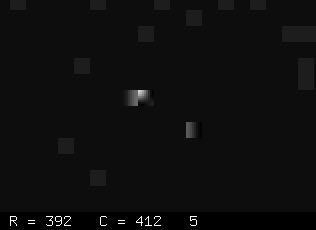
Let's look at the light curves for three objects -- target "A", bright star "B", faint star "C" -- derived from each set of images. First, the frames converted directly from raw video.

Next, the frames derived from a Cinepak video.
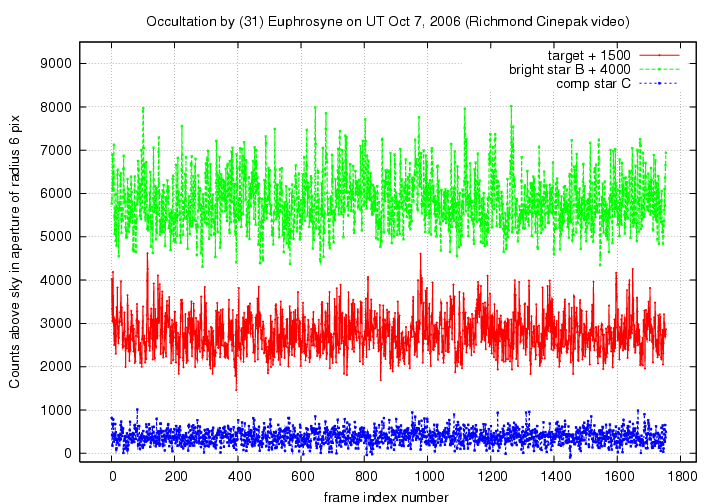
Finally, the frames derived from the heavily compressed DivX video.

The gross characteristics are the same in all cases. However, we can see some differences if we zoom in a bit. Let's look at a set of 30 frames.

The direct and Cinepak frames track each other pretty well. The DivX frames show choppier behavior.
If we compare the Cinepak to the direct frames, we see pretty good agreement. The green symbols on the plot below are the differences (shifted by -500 counts) between the target star's brightness in Cinepak and the target star's brightness in direct frames.
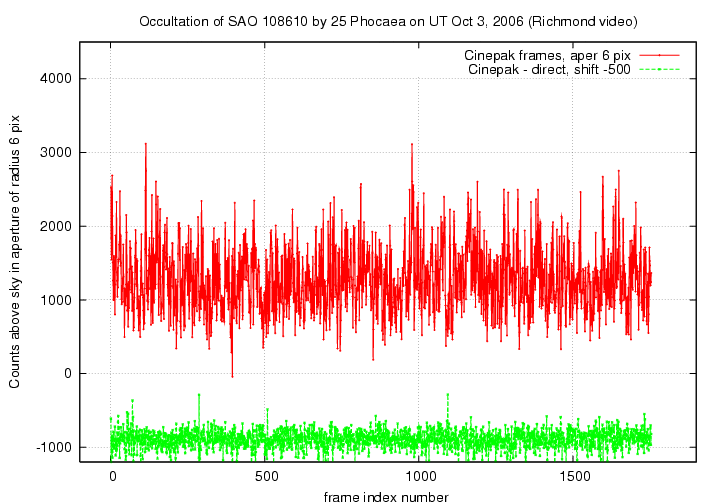
It is very instructive to look at the sky values derived from each set of frames. In theory, the background sky value should remain constant, with slow changes due to changing altitude, moonshine, thin clouds, and so forth. The DivX sky values, however, occasionally jump by large amounts:
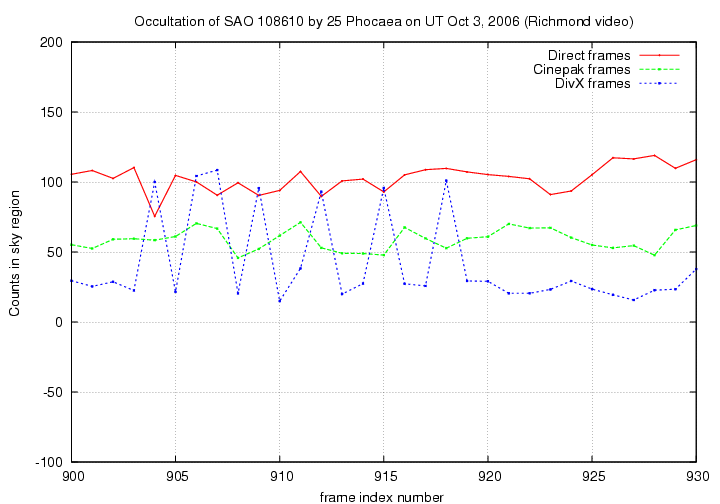
For a quantitative measure, we can look at the statistics of each star's brightness over the entire video clip, or some small section. In theory, since no occultation occurred, each star should have a constant value. There will be random variations from frame to frame, and those variations should be larger for faint objects.
star method entire clip scatter frames 900-930
mean sigma % mean sigma %
-----------------------------------------------------------------------
A direct 1667 458 27 1411 392 28
Cinepak 1274 438 34 1006 351 35
DivX 892 499 56 677 409 60
B direct 2215 617 28 2201 467 21
Cinepak 1812 596 33 1781 481 27
DivX 1462 682 47 1392 608 44
C direct 695 185 27 708 180 25
Cinepak 383 164 43 421 159 38
DivX 83 177 213 80 166 208
---------------------------------------------------------------------
The direct method yields photometry with the smallest scatter in all cases. The Cinepak compression increases the scatter by a small amount; it also decreases the mean level of each star. Hmmm. The DivX compression increases the scatter greatly, especially in the case of the faint star "C"; in a number of frames, light from that star is not detected.
You can grab the data in multi-column ASCII text files below. The columns are
col quantity
------------------------------
1 frame index
2,3 flux of target star "A" in 4-pixel-radius aperture,
and estimate of uncertainty in that flux
4,5 ditto 6-pixel aperture
6,7 ditto 8-pixel aperture
8,9 flux of bright star "B" in 4-pixel-radius aperture,
and estimate of uncertainty in that flux
10,11 ditto 6-pixel aperture
12,13 ditto 8-pixel aperture
14,15 flux of faint star "C" in 4-pixel-radius aperture,
and estimate of uncertainty in that flux
16,17 ditto 6-pixel aperture
18,19 ditto 8-pixel aperture
 Copyright © Michael Richmond.
This work is licensed under a Creative Commons License.
Copyright © Michael Richmond.
This work is licensed under a Creative Commons License.